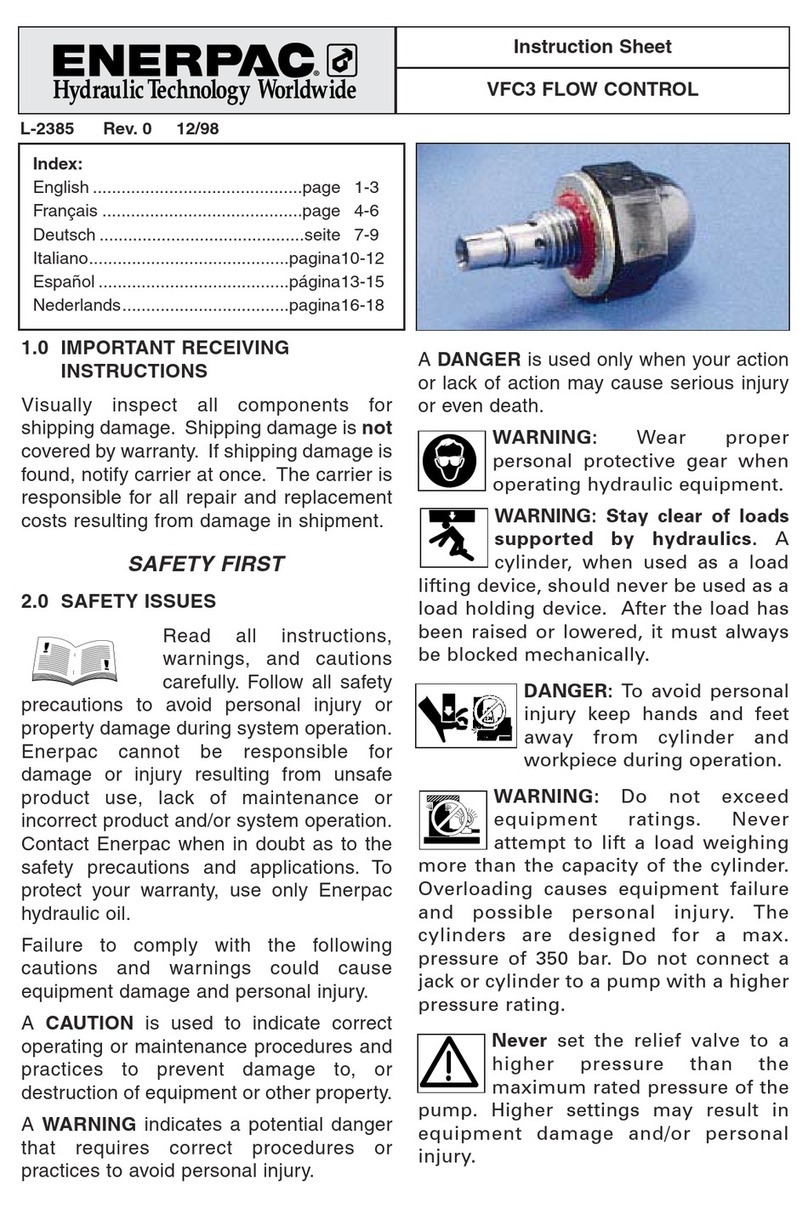3
3.0 GENERAL DESCRIPTION/GLOSSARY OF TERMS
The Enerpac Synchronous Lift System is a package that provides
precise positional control of the lifting and lowering of high
tonnage objects. The microprocessor-based
controller receives electronic signals from
load position sensors attached to the load in
the vicinity of each cylinder. The controller
processes this information and sends signals
to the valves controlling each cylinder,
opening and/or closing the valves as required
to raise or lower a load evenly and within the
accuracy parameters defined by the operator.
The Enerpac Synchronous Lift System
consists of the basic components shown
below. Refer to Figure 3 for the layout of a
typical four point lift system.
3.1 Standard Components
(refer to Fig. 1)
CONTROLLER, SLCG-8
The CONTROLLER is where the operator
selects the lift parameters and controls
up to eight lift points. The CONTROLLER
distributes signals to the appropriate CYLINDER CONTROL
VALVES, causing them to open or close, as necessary, to
control the lifting or lowering functions.
CYLINDER CONTROL VALVES, SLCV-24 (24 volt coils)
The CYLINDER CONTROL VALVES receive on/off commands
from the controller. These valves open and close, controlling
flow into the cylinders as they advance, or controlling flow out
of the cylinders as they retract, keeping the load moving in a
controlled synchronous motion while maintaining the
accuracy desired by the operator.
PUMP DIRECTIONAL CONTROL VALVE CABLE, SLPVC-1
Connects PUMP DIRECTIONAL CONTROL VALVE to the
SLGG-8 controller.
STROKE SENSOR, SLSS-500, 1000, 2000
Contains the electronics to detect load movement.
SENSOR CABLE (SLSC-15)
The SLSC15 (15 meters) SENSOR CABLE transmits sensor
feedback to the CONTROLLER. Optional cable extensions
(SLEC 15 & SLEC 50-meter lengths) are available to permit
sensor placement farther than 50 feet.
CHECK VALVE PACKAGE (SCK-1) (not shown)
The PILOT-OPERATED CHECK VALVE
provides additional safety margin for load
holding in the event of a leaking or ruptured
hose. Useable on both double- and single-
acting cylinders. VELOCITY FUSE locks and
holds the cylinder position in the event of a
catastrophic hose failure. Useable on single-
and double-acting cylinders. The VELOCITY
FUSE can be used in lieu of the CHECK VALVE
PACKAGE in some cases. Consult Enerpac on
specific recommendations.
HYDRAULIC PUMP
The HYDRAULIC PUMP provides flow to the
HYDRAULIC CYLINDERS allowing them to
advance or retract. The CONTROLLER
operates the pump-mounted DIRECTIONAL
CONTROL VALVE.
HYDRAULIC CYLINDER (single- or
double-acting)
The HYDRAULIC CYLINDER lifts or lowers
the load.
CYLINDER CONTROL VALVE CABLE, SLCVC
Connects CYLINDER CONTROL VALVE to SLCG 8 Controller.
PRESSURE GAUGES (Optional, not shown)
PRESSURE GAUGES allow the operator to monitor system
pressures.
DIRECTIONAL CONTROL VALVE
The pump-mounted or remote-mounted DIRECTIONAL
CONTROL VALVE controls the advance and retract flows of
hydraulic fluid and is managed by the CONTROLLER.
CYLINDER CONTROL VALVE
Model No. Power Pressure Rating
SLCV-24 24 Volts (35 watts) 10,000 psi (700 bar)
IMPORTANT: The ENERPAC
PLC BASED SYNCHRONOUS
LIFT SYSTEM is a precision
position control system,
which can be used in a wide
variety of applications. Make
certain that user supplied
components are compatible.
All operators should read and
thoroughly understand this
operating manual before
using the equipment.
SLCG-8
Operating Temperature Range: 32 °F to 115 °F (0 °C to 46 °C)
Storage Temperature Range: 32 °F to 140 °F (0 °C to 60 °C)
Enclosure Rating – Closed NEMA 4 (IP60)
Enclosure Rating – Open NEMA 1 (IP20)
Power: 115/230 VAC, 50/60 Hz, 15-amp maximum
Physical Dimensions: 24 in x 20 in x 8 in (61 cm x 50.8 cm x 20.3 cm)
CAUTION: The CONTROLLER is designed to be water-resistant
when closed but not waterproof. Avoid working in direct sunlight, while
not causing damage, the display can be difficult to properly view. When
storing unit, always make sure that the cover is closed and stored out
of the weather. The CONTOLLER is a sensitive piece of electronic
equipment and should not be subjected to shock, rain, snow, sand or
very dusty conditions.
SENSOR: SLSS-500, 1000, or 2000
Measuring Range:
SLSS-500 – 0-19.7 in (500 mm) of cord extension
SLSS-1000 – 0-39.4 in (1000 mm) of cord extension
SLSS-1000 – 0-78.7 in (2000 mm) of cord extension
Operating Temperature Range: -4 °F to 176 °F (-20 °C to 80 °C)
Storage Temperature Range: -40 °F to 176 °F (-40 °C to 80 °C)
Stainless steel eyelet and magnets for securing to load
CAUTION: The SENSOR is also designed to be water
resistant, but not waterproof. Do not immerse in liquid. The
SENSOR is also a sensitive piece of electronic equipment and
should not be subjected to severe shock, rain, snow, sand or very
dusty conditions.
ELECTRICAL COMPONENT SPECIFICATIONS






























